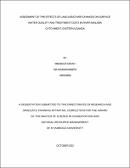| dc.description.abstract | Changing land use and cover (LULC) is a major contributor to water quality degradation in various
regions of the world. Unfortunately, there are not enough data on how LULC change affects water
quality and prices in different catchments. Therefore, the research has covered gaps left by
previous research by looking at three different aspects of the River Malaba catchment: first, the
extent to which land use and cover have changed, second, the impact that land use has had on
water quality, and finally, the impact that water quality has had on treatment costs. Sentinal-2
images of 2015 and 2021 were downloaded and analyzed using GIS. Water samples were picked
at different land use/ cover types along the river and analyzed for physical-chemical as well as
bacteriological parameters, statistical tools such as ANOVA at 95% confidence interval were done
to understand land use/cover influence on water quality. Costs of water treatment influenced by
water quality were analyzed retrospectively using data from the National Water and Sewerage
Corporation and ANOVA at a 95% confidence interval. Results indicated LULC patterns shifted
radically between 2015 and 2021, with most conversions to farming. The farmlands (15.3%) and
built-up (1.0%) increased over time as woodlands (-2.8), grasslands (-13.2), and wetlands (-0.2)
shrunk during the study period. Land use/cover significantly affected COD (P=0.023), Electrical
Conductivity (P=0.004), and Nitrate levels (P=0.004), COD was observed highest in farmland and
least in woodlands, and EC and Nitrates were highest in wetlands and also least in woodlands.
Seasons also showed significance across all water quality parameters except for Feacal Coliforms
(P=0.233) Total Phosphates (P=0.943) and Total Iron (P=0.147). Water quality parameters
significantly affected the costs of Aluminium Sulphate, high-test hypochlorite, and polymer. Costs
of water treatment were high downstream than the upstream, also in the rainy season than in the
dry season.
These findings suggest that River Malaba basin has been subjected to LULC changes as a result
of human activities, which has repercussions on the quality of water, hence increasing the cost of
water treatment. This has repercussions for the livelihoods and well-being of humans, for instance
by increasing the likelihood of disease and limiting the use of water to provide material items such
as food. Therefore, interventions should be implemented to conserve these catchment regions. In
addition, because this study was conducted over a short period of time and with limited monitoring
of water quality and trends in water treatment costs, future studies should be clear in examining
LULC developments over time and how they relate to water quality and treatment costs. | en_US |

